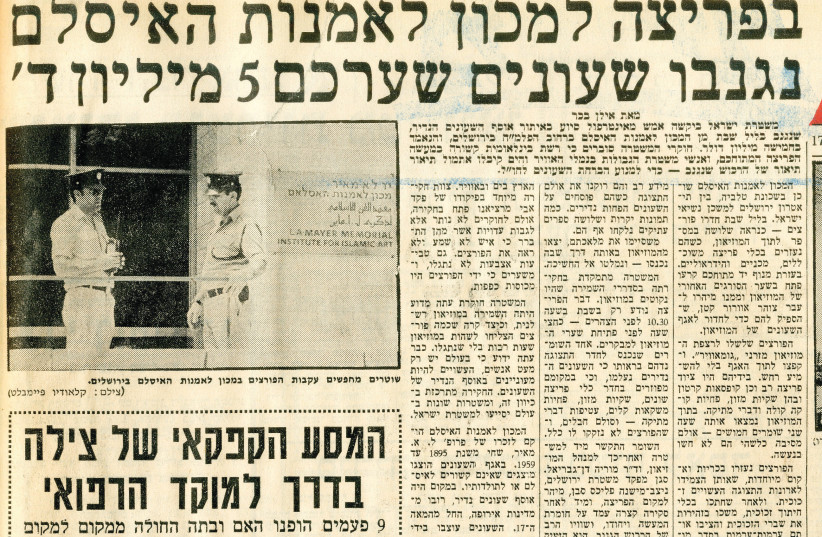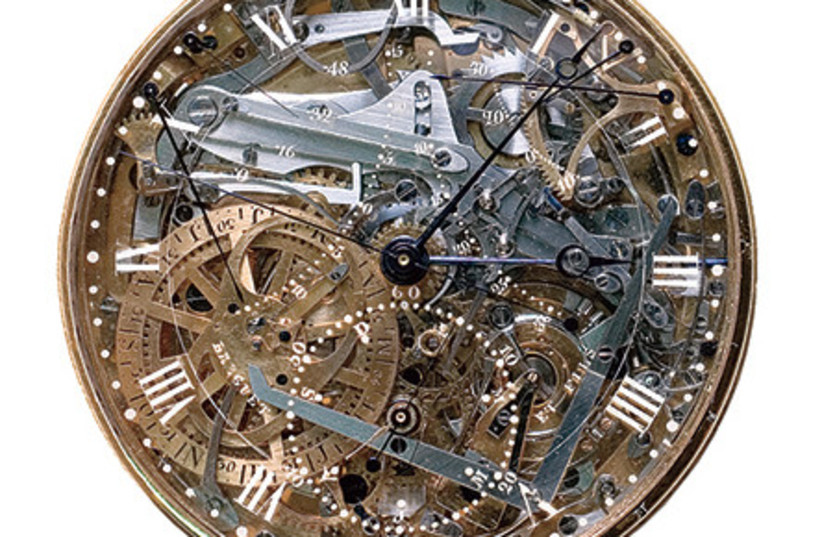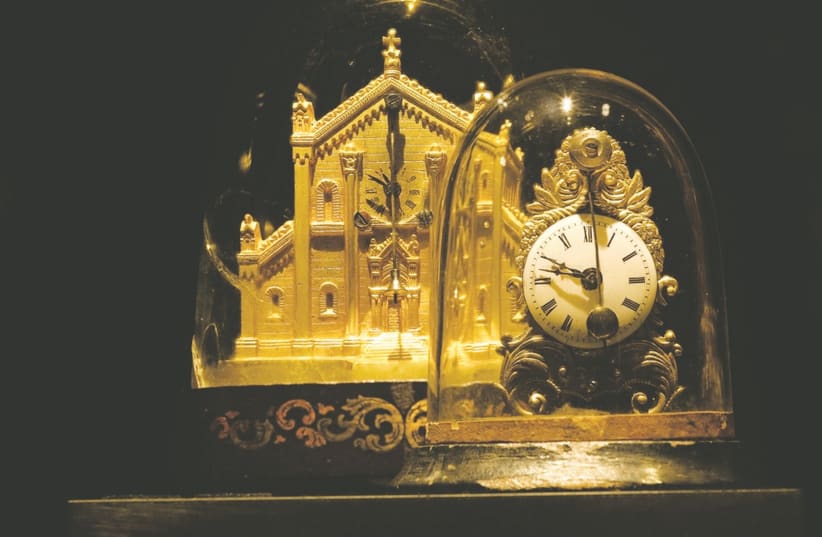Even the most talented TV and movie screenwriter would have had a hard time coming up with the following storyline: Imagine that the most sophisticated thieves from the show La Casa de Papel meet up with Marie Antoinette in a quaint museum in Jerusalem, after which it is discovered that 106 rare clocks, valued at over $150 million, have disappeared… and are only recovered 25 years later.
Does this sound like an absurd story? Well, the police investigators and staff at the Museum for Islamic Art in Jerusalem who were involved in the search for the missing clocks might not think so. The theft, which took place in 1983, came to be known as the biggest and most daring heist in Israeli history. The stolen clocks were then dispersed to locations on three different continents.
Visitors are welcome to join a tour at the Museum for Islamic Art in Jerusalem, during which they will see the new exhibition featuring the stolen clocks and hear the story of the theft and the years-long investigation that ended with the return to Israel of almost all the items.
“The story of the theft is as big a magnet for visitors as is the collection itself. That’s why over the years, the spotlight has been focused greatly on the mystery and audacity of the robbery, and less on the dry details. Its storyline could be the plot of a Hollywood film.”
Avishai Yarkoni
“The story of the theft is as big a magnet for visitors as is the collection itself,” explains Avishai Yarkoni, the museum’s marketing and events manager, who was present when the first items from the clock collection were returned in 2006. “That’s why over the years, the spotlight has been focused greatly on the mystery and audacity of the robbery, and less on the dry details. Its storyline could be the plot of a Hollywood film.”


The biggest heist in Israeli history
When the museum staff entered the hall where the clocks were exhibited on the morning of April 17, 1983, they could not believe what they saw: The room, which just the day before had contained the entire collection of rare clocks, was completely empty. The only things that remained in the room were a few tools that had been used to open the display cabinets, and a few candy wrappers that had been apparently left by the thief. He had spent the long night packing up the entire extensive collection and transporting them to his vehicle, under the noses of the two security guards who were on duty.
“The hall had been secured with a limited security system,” explains Jenya Frumin, a senior tour guide at the museum. “The concept of using advanced security measures to secure artwork in Israel was still in its infancy at the time.
“The thief had accessed the building through the air vents, which are located in the wall facing the street. He apparently backed his car up to that wall, and thus blocked the view of the vents from the street. The thief spent the entire evening in the clock hall, during which time he attached a stethoscope to the door, forced the vitrine displays open, and took all 106 of the valuable, rare clocks.”
The third-largest rare clock collection, valued at $150 million
THE COLLECTION, which is considered the third-largest rare clock collection in the world, was bequeathed to the museum by the daughter of Sir David Salomons, Vera Bryce Salomons, founder of the museum. The value of the collection, which is estimated at $150 million, includes 40 items created by Abraham Louis Breguet, an 18th-century Swiss clockmaker and physicist. The most famous of Breguet’s clocks in the collection was created for Marie Antoinette. It is valued at NIS 50 million and is known as the Mona Lisa of clocks.
“This is one of the first collections of mechanical items that appear in clocks, mechanical toys and musical boxes created in the 18th and 19th centuries,” Frumin explains. “The collection came with a scientific catalog, which was rare for that period, and a great amount of money had been invested in it.
“The Marie Antoinette clock is considered to be the most sophisticated clock ever made. It has 823 individual pieces made from gold, platinum and crystal. It was considered the smartphone of the 19th century, since it had more than 10 mechanical panels that moved simultaneously, and it had taken many years to build.”


The Jerusalem police investigation
The burglary case was investigated by the Jerusalem Police’s Serious Crime Division, which immediately began probing this crime, which spanned continents. A $2 million reward (guaranteed tax-free by the Finance Ministry) was offered for locating the lost collection.
“All the museum employees were interrogated,” Yarkoni says. “At first, the investigators suspected that Ohans Marquire, our esteemed watchmaker who was in charge of the collection and knew how much it was worth, was connected to the theft. But soon, of course, he was found to be completely innocent.”
Museum officials assumed that the thief had been familiar with the collection and had known how much the collection was worth. Complaints were made about the lack of security infrastructure. Once in a while, someone would call with information and demand the reward money. A rumor circulated that the United Arab Emirates had been behind the heist, since it was unthinkable that a single person could steal such a valuable collection. Never in their wildest dreams did anyone imagine that the thief was an Israeli kibbutznik.
The Israeli criminal mastermind: Na’aman Diller, who pulled off the heist alone
During the investigation, a slew of known criminals who could potentially have been capable of pulling off such a large-scale heist were questioned. One was Na’aman Diller from Kibbutz Ein Hahoresh, who had done time in prison for breaking and entering. Diller was interrogated, but he had provided a (fake) stamp on his passport from the Airports Authority, which proved that he was overseas at the time of the theft.
Diller had already died by the time the authorities discovered that he had been the one who had carried out the theft – all on his own. Apparently, he had parked his car in a way that blocked the view from anyone walking by and had entered and exited the museum many times as he filled up his car with the valuable timepieces.
“Diller had entered through a window in the back. He’d used a hydraulic jack to widen the metal bars and had managed to get inside with the help of a rope ladder. He left all of these items at the museum. Diller went in and out of the museum a number of times over Friday and Saturday. Because he had what they thought was a solid alibi, he was removed from the list of suspects.”
Sgt.-Maj. Oded Yaniv
“Diller had entered through a window in the back. He’d used a hydraulic jack to widen the metal bars and had managed to get inside with the help of a rope ladder,” explains Sgt.-Maj. Oded Yaniv, who headed the team investigating the case that was reopened in 2007.
“He left all of these items at the museum. Diller went in and out of the museum a number of times over Friday and Saturday. Because he had what they thought was a solid alibi, he was removed from the list of suspects.”
After 25 years, a clue was finally found
FOR 25 YEARS, the police failed to come up with a single clue to solve the mystery. Then in August 2006, a known watchmaker from Tel Aviv called the museum and asked to speak with the curator, saying that he had been asked to give a valuation of 39 clocks. He recognized immediately that the pieces belonged to the lost collection. A few days later, the museum received a phone call from a lawyer who represented an unnamed client who was interested in negotiating the return of 39 items from the museum’s lost collection in exchange for payment. The museum agreed to pay NIS 150,000 for them.
“After the curator’s conversation with the Tel Aviv watchmaker, the information he’d relayed was shared with only a few staff people. Moreover, they had decided not to inform the police, since they had agreed to the confidentiality request from the lawyer representing the woman, who turned out to be Diller’s widow,” Yarkoni explains.
“And indeed, the museum’s board of directors agreed to keep this information secret. Fourteen months later, the story was printed on the front page of Haaretz. It didn’t take long for policemen to appear in my office, asking me lots of questions. At that point, the investigation was reopened,” he recounts.
It soon became public that the offer to return the clocks had come from Diller’s widow, Nili Shomrat, who had only been made aware of the valuable collection of timepieces when her husband lay on his deathbed. In November 2007, the Jerusalem Serious Crime Division investigative team made a breakthrough that led to the truth.
“We began by investigating the museum staff members, and our forensics team took a closer look at the clocks that had been returned to the museum. We were looking for clues that might lead us to the thief’s identity,” Sgt.-Maj. Yaniv explained. “There were little notes hidden inside the clocks with explanations of how to disassemble and then put all the pieces and springs back together again.
“These were extremely helpful for us in our investigation. We knew that the lawyer would not cooperate with us, so we operated covertly for the time being. The name of the widow had also been withheld from the museum, whose staff, it should be noted, cooperated with us fully.


“Through the watchmaker who had been hired to estimate the value of the clocks, we arrived at a storage facility in Ramle, where we found a copy of the power of attorney signed between the lawyer who had rented the safe and her client – Nili Shomrat. That was how the connection to Na’aman Diller was corroborated.
“We continued with our investigation, and later discovered that Diller had often stayed overnight in hotels overseas in the 1980s and 1990s. We worked in conjunction with police departments in cities throughout Europe and managed to locate addresses, safe deposit boxes and documents owned by Diller. We even discovered that there were still safe deposit boxes that were being paid for, despite the fact that Diller had died in 2004. We later found out that his wife had continued paying for them.”
Diller’s wife returned only 39 clocks to the museum.
How did you locate another 67 pieces?
“We went to all the cities where Diller had storage units and safe deposit boxes. Our first stop was a storage unit in the Hague in the Netherlands. Together with the local authorities in each location, we were able to locate a number of antique clocks, paintings and books, which we compared against lists we had from the museum’s catalog. We also found a number of Diller’s fake passports and equipment used to forge documents, along with lots of passport pictures and stamps from various airports around the world.
“This was the first time we’d uncovered an actual connection between Diller and the items. Of course, we handed off all the items directly to the museum, which they confirmed were indeed from the stolen clock collection. Granted, we had only located five items, but we were overjoyed because it was the first real success we’d achieved so far.
“Next, we interrogated Diller’s widow, Nili Shomrat, who now lives in the US, as well as her lawyer, who lives here in Israel. At Shomrat’s home, we located antique oil paintings that we found under her bed, as well as letters and an article from 1983 about the theft. At first, she denied everything. Later, she told us that just before he died, Diller had admitted to carrying out the heist and had explained to her where she could find the safe deposit boxes and how to return the 39 clocks, including the Marie Antoinette clock, to the museum.
“After he died, Shomrat continued paying for the safe deposit boxes, but she never visited any of them. It seems that she wasn’t really involved in anything and just didn’t know what to do with the items she had inherited. In the US, she was charged with possession of stolen goods and money laundering. Because of her age and the fact that she’d returned the clocks, she only had to pay a high fine and carry out community service. Neither Shomrat nor her lawyer had cases brought against them here in Israel.”
The stolen clocks in France
The hunt for the rest of the items taken in the theft led the investigators to France. “We found the largest number of items in France,” recalls Yaniv. “Spread throughout a number of safes, we found the rest of the items inside plastic bags that were wrapped up in newspapers. One hundred and six of these items were identified, then returned to the museum.
“The evidence was conclusive: Diller’s fingerprints were found on the items, and the handwriting on notes that were found with the items was determined to be Diller’s. All of this, in conjunction with Shomrat’s confession, led us to understand that Diller had carried out the theft. And anyway, most of the items had been recovered.”
“We believe that he didn’t carry out the theft for the money but instead for the thrill of it. He yearned to succeed in doing the impossible, to achieve an incredible feat... he loved clocks and he also loved carrying out heists.”
Sgt.-Maj. Oded Yaniv
One of Israel’s greatest burglars
Na’aman Diller (also known as Na’aman Lidor) was one of the most sophisticated burglars in Israeli history. He had served time in prison in the 1960s and 1970s for breaking into a bank in Tel Aviv in 1967 by digging a tunnel that led up into the bank’s vault.
“We believe that he didn’t carry out the theft for the money but instead for the thrill of it,” adds Yaniv. “He yearned to succeed in doing the impossible, to achieve an incredible feat. I mean, he didn’t really want to own the Marie Antoinette clock, but he loved clocks and he also loved carrying out heists. He was self-taught and had done a lot of research and experimentation with disassembling and reassembling clocks.
“He tried to alter their outward appearance so that he could sell them, but only succeeded in selling three of them. He apparently felt very connected to the clock collection, and perhaps that’s why he never took apart any of the clocks made by Abraham Louis Breguet.”
In addition to the three items Diller sold, the location of 34 items that were never recovered remains a mystery.
How did the Israeli museum restore the recovered stolen clocks?
RESTORING THE clocks that had been disassembled turned out to be quite a challenging feat, and it took more than six years to complete. Most of the clocks had been crafted in the 18th and 19th centuries and could not be assembled with contemporary tools.
“Boris Sankov, who worked as the museum’s watchmaker at the time, was extremely talented. He took Diller’s notes and together with Sir David Salomons’ scientific catalog of the collection, worked diligently to put all the pieces back together,” Frumin explains.
“Sankov consulted watchmakers all over the world, and the ancient lathes he used are still located in the museum. There was no other way for him to produce spare parts and reassemble the clocks with modern technology.
“There were also a few items that Sankov could not reassemble on his own, such as the fan clock. In the end, Sankov received help with the artistic restoration of these items from the lab at the Israel Museum. Diller had not disassembled the Breguet clocks, though, since he knew how complex they were, and probably realized that he would not be able to reassemble them.
“One of the reasons we give guided tours of the clock collection, according to the wishes of the donors, is to display their great value to the public,” Frumin concludes. “But what is an even greater draw to these tours is the story of the heist and the subsequent return of the clock collection to the museum.
“Many people had never heard about the collection until after the theft took place. There’s no doubt that such an event ignites our imagination. It’s a bit like Hollywood meets Netflix.”
Translated by Hannah Hochner.












